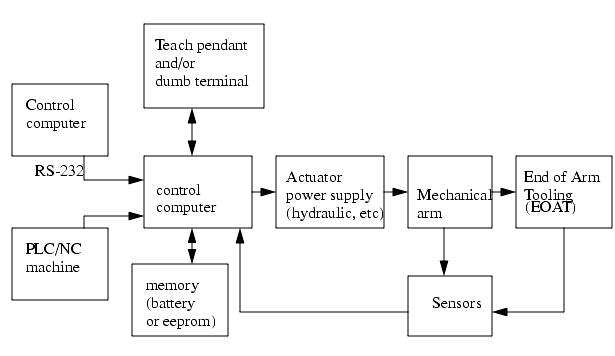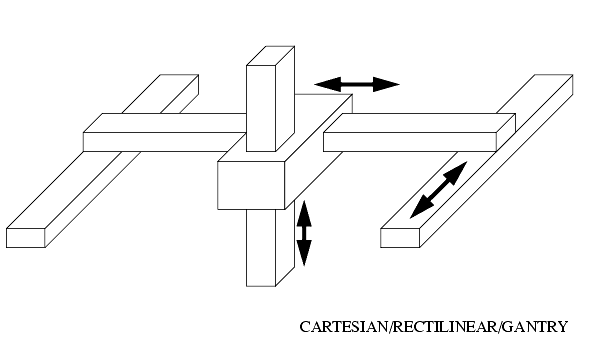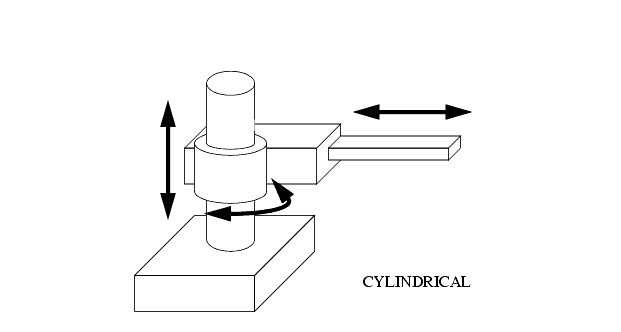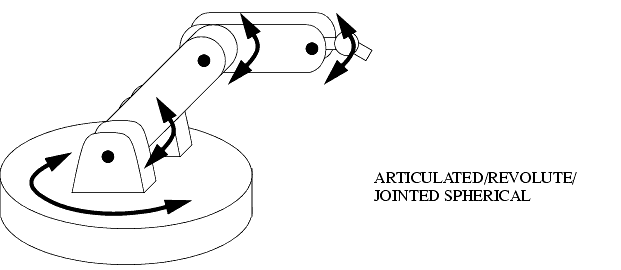14.2 ROBOT TYPES
������������
14.2.1 Basic Robotic Systems
������������
The basic components of a robot are,
Structure - the mechanical structure (links, base, etc). This requires a great deal of mass to provide enough structural rigidity to ensure minimum accuracy under varied payloads.
Actuators - The motors, cylinders, etc. that drive the robot joints. This might also include mechanisms for a transmission, locking, etc.
Control Computer - This computer interfaces with the user, and in turn controls the robot joints.
End of Arm Tooling (EOAT) - The tooling is provided be the user, and is designed for specific tasks.
Teach pendant - One popular method for programming the robot. This is a small hand held device that can direct motion of the robot, record points in motion sequences, and begin replay of sequences. More advance pendants include more functionality.
14.2.2 Types of Robots
������������
Robots come in a wide variety of shapes, and configurations.
The major classes of robots include,
arms - fixed in place, but can reach and manipulate parts and tools
mobile - these robots are free to move
14.2.2.1 - Robotic Arms
������������
Typical joint types are,
Revolute - rotary joints often driven by electric motors and chain/belt/gear transmissions, or by hydraulic cylinders and levers.
Prismatic - slider joints in which the link is supported on a linear slider bearing, and linearly actuated by ball screws and motors or cylinders.
Basic configurations are,
Cartesian/Rectilinear/Gantry - Positioning is done in the workspace with prismatic joints. This configuration is well used when a large workspace must be covered, or when consistent accuracy is expected from the robot.
Cylindrical - The robot has a revolute motion about a base, a prismatic joint for height, and a prismatic joint for radius. This robot is well suited to round workspaces.
Spherical - Two revolute joints and one prismatic joint allow the robot to point in many directions, and then reach out some radial distance.
Articulated/Jointed Spherical/Revolute - The robot uses 3 revolute joints to position the robot. Generally the work volume is spherical. This robot most resembles the human arm, with a waist, shoulder, elbow, wrist.
Scara (Selective Compliance Arm for Robotic Assembly) - This robot conforms to cylindrical coordinates, but the radius and rotation is obtained by a two planar links with revolute joints.
14.2.2.2 - Autonomous/Mobile Robots
������������
The robots discussed up to this point have concerned `arms' that are fixed to the floor. Another important class of robots are autonomous, and free to move about the workspace.
Typical applications are,
- nuclear accident cleanup
- Automatic Guided Vehicles in factories
14.2.2.2.1 - Automatic Guided Vehicles (AGVs)
These are typically wheeled robots that carry payloads through a factory.
They navigate using,
- wires embedded in floors
- light sources or reflectors
- colored tapes on the floor








